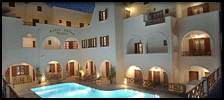
Archaeological Museum of Santorini (Fira)
It was created in 1960 from the Ministry of Public Work with a view to it replaces the old museum (that was built in 1920), which collapsed at the duration of earthquake 1956. Was created in 1960 from the Ministry of Public Work with a view to it replaces the old museum (that was built in 1920), which collapsed at the duration of earthquake 1956. The museum contains the following collections: Sculpture, from the Archaik until and the Roman period. Signs, from the Archaik until and the Roman period. Vessels and earthen statuettes, from the Geometrical until and the Hellenistic period. The more important points of report are:
Artifact No. 1783
Thiraic poterry with geometrical decoration. Representative example of local laboratory, the production of that begins in the dues of the 8 oy century p.H. and lasts until the 6 century p.H. As it was realised at the Archaik of cemetery of ancient Thira and is dated by the beginning of the 7th century B.C.
Artifact No. 777
Pot from the cemetery of Ancient Thira. It is a island that was given in laboratory and the dates for the beginning of the 7th century B.C.
Artifact No. 1320
Big pot with decoration. Brilliant example of the 7 th century B.C. Cycladic Art, but also the unique sample for the Thira. The metopes with his neck the vessel is decorated with a swan and the band for scapula shows two chariots that dressed with horses. It emanates from a children's burial in the cemetery of Archajk Thira, in northern side of mountain. It is dated in calcium. 675 B.C.
Artifact No 306
Uper part of one ancient Kouros. He is one from the first known colossal statues, that were found in the cemetery of ancient Thira, in the westerner sides of mountain. It is dated in the end of the 7 th century B.C.
Artifact No. 307
Trunke of ancient engraved Kouros from the cemetery ancient Thira, in the westerner sides of mountain. It is dated in the end of the 7 th century B.C.
Artifact No. 392
Figurine made from mud' that you cover with painting decoration of which the colour continues being well maintained. Because the characteristics of circulation of hands to the head, it has been interpreted as sad. It is dated in the end of the 7 th century B.C.
Artifact No. 1772
Attic black pot. At the front side, Athina and the Hercules have shown a parasitic scene, while in the backstage they are portrayed the Apollo she plays lyra, and the Artemis. The other aspect is decorated with two riders is framed from archer and a soldier. The dead person name is in verge his vessel. As it was realised at the Archaic of cemetery of ancient Thira and is dated from the second half 6 th century B.C.
Artifact No. 1773
Attic black Pot. In his exterior surface vessel, a chariot of battle and a duel between two soldiers are portrayed scenes between leave warriors. By the interior, six boats are portrayed in verge and the Neptune in the centre, killing the giant. By the base, two riders they are portrayed in the two sides of soldier. As it was realised at the ancient cemetery of ancient Thira and is dated from the second half 6 th century B.C.
Artifact No. 1774
Attic Blue Color crater. By the neck are portrayed scenes with chariots of battle, in that participates the view Athina. His internal surface verges is decorated with four boats. By the cemetery of ancient Thira, it is dated in the second half 6 th century B.C.
Artifact No. 509
Volcanic (trahjtis)rock weights 480 kilos. It was it is raised by the athlete Eymasta with naked hands his and realisation it is monument in a sign with the same Stone: "Eymastas, son of Kritovoloy, raised my in the open sea of ground".
Hours of Operation – Summertime 2009
Each day except Monday: 08:30 - 15:00,
Tel: 2286022217
Useful Info
 Shopping
Shopping Architecture
Architecture Entertainment
Entertainment Food
Food The Volcano
The Volcano History
History Morals and customs
Morals and customs Beach
Beach Access
Access Transportation
Transportation Useful Info
Useful Info Local Products
Local Products


